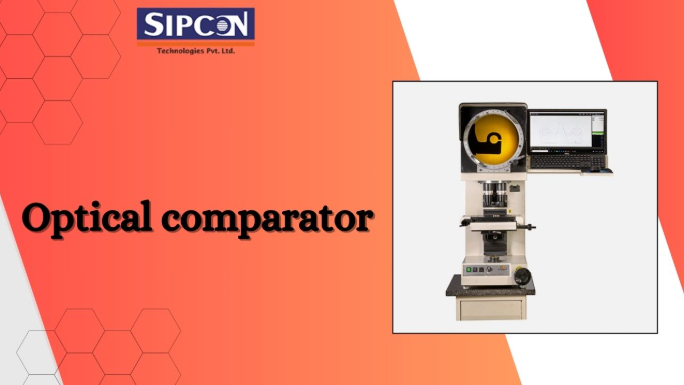Measuring small parts or checking the shape of an object is demanding. An optical comparator serves the purpose of measuring with higher accuracy. It is a simple yet powerful instrument to ensure that every part made is the right size and shape.
This article explains the definition of an optical comparator, its working principle and usefulness.
What Is an Optical Comparator?
Knowing an optical comparator is necessary for a better understanding of the equipment. An optical comparator is a machine that uses light to magnify and display the shape of an object on a screen so you can compare it with a standard shape.
You place a small part on the platform and the machine projects a magnified image of it on a screen. This helps you check if the part has the correct size, angle or shape.
In simple words, it is like a projector and a ruler combined where you can look at the part’s image and measure it without touching it.
How Does an Optical Comparator Work?
Here is a simple step-by-step explanation of how it works:-
Place the part on the stage – The part you want to check is placed on a glass platform.
Light passes through or reflects off the part – Light either passes through clear parts or reflects off solid parts.
The image is magnified – A lens system enlarges the image of the part.
The image appears on a screen – This magnified image is shown on a large screen where you can see the details clearly.
Compare and measure – You can then compare this image to check if the part matches the required specifications.
What Are the Benefits of an Optical Comparator?
o Non-contact inspection
You do not need to touch the part while measuring which is perfect for delicate or tiny items.
o High accuracy
It gives you very accurate readings, especially when working with small or detailed parts.
o Fast inspection
You can inspect multiple features at once just by looking at the magnified image.
o Easy to use
Most machines are simple to operate and do not require advanced technical skills.
o Ideal for repetitive checks
An optical comparator lets you quickly compare each one to a standard template if you are making hundreds of the same part.
o Cost-effective
Optical comparators are relatively affordable and offer great value for their precision compared to some high-tech equipment.
Must-have features
Screen size
A larger screen size gives you a better view of the magnified part. Choose the perfect size based on the size of the parts you will be inspecting.
Magnification lenses
Check how many lens options are available. More lenses mean more flexibility in how much you can zoom in or out.
Lighting system
Good lighting is essential for a clear image. Make sure the machine has adjustable surface and contour lighting, especially if you work with different types of parts.
Accuracy and measurement range
Look for a machine with high measurement accuracy and a measurement range that suits your needs.
Build quality and stability
Choose a comparator with a strong and stable frame. Even small movements can affect the accuracy of your measurements if the frame is not strong and steady.
Ease of calibration
Make sure it is easy to calibrate the machine so you can maintain accuracy over time.
Conclusion
Overall, an optical comparator is a smart tool to help you check parts and keep your product quality high. Always remember to take time to explore your options and compare brands before you invest. Choose a reliable manufacturer that offers after-sales support, training and calibration services.
Have a look at the profile projector machine that brings precision to every part you inspect

